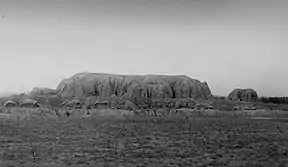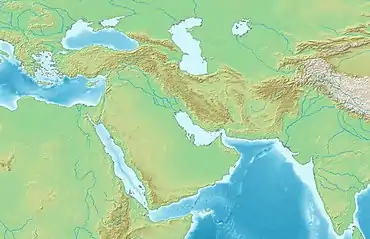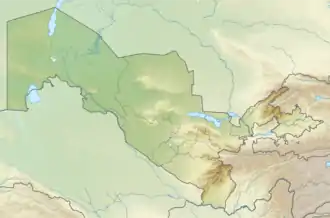Kafir-kala (Uzbekistan)
Kafir-kala ("Fortress of the infidels") is an ancient fortress 12 kilometers south of the city center of Samarkand in Uzbekistan, protecting the southern border of the Samarkand oasis.[2] It consists in a central citadel built in mud-bricks and measuring 75 × 75 meters at its base has six towers and is surrounded by a moat, still visible today.[2] Living quarters were located outside the citadel.[2]
The citadel was first occupied by the Kidarites in the 4th-5th century CE, whose coinage and bullae have been found.[3][4]
Many examples of coinage were excavated in Kafir-kala, which also show the transition from Sogdian to Islamic rule in the area of Samarkand with good precision.[5]
 Ruins of Kafir Kala
Ruins of Kafir Kala.jpg.webp) Ruins of Kafir Kala
Ruins of Kafir Kala
External links
References
- "Antiquities of Samarkand. Kurgan in the Vicinity of Samarkand. Location of Kafir Kala". www.wdl.org. 1868.
- Mantellini, Simone (2012). "Change and Continuity in the Samarkand Oasis: Evidence for the Islamic Conquest from the Citadel of Kafir Kala". Journal of Inner Asian Art and Archaeology. 7: 227–253.
- "Administration, law and urban organization in the Late Antique and Early Medieval period". Universitetet i Bergen (in Norwegian Bokmål).
- "The Kidarites in Bactria". pro.geo.univie.ac.at. Coin Cabinet of the Kunsthistorisches Museum Vienna.
- Gariboldi, Andrea. "NUMISMATIC FINDS FROM KAFIR KALA AS EVIDENCE OF THE ISLAMIC TRANSITION IN SAMARKAND" (PDF). Cite journal requires
|journal=(help)
This article is issued from Wikipedia. The text is licensed under Creative Commons - Attribution - Sharealike. Additional terms may apply for the media files.



.jpg.webp)